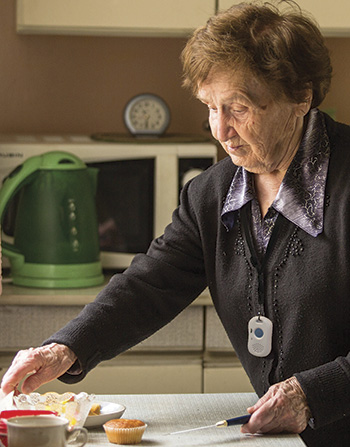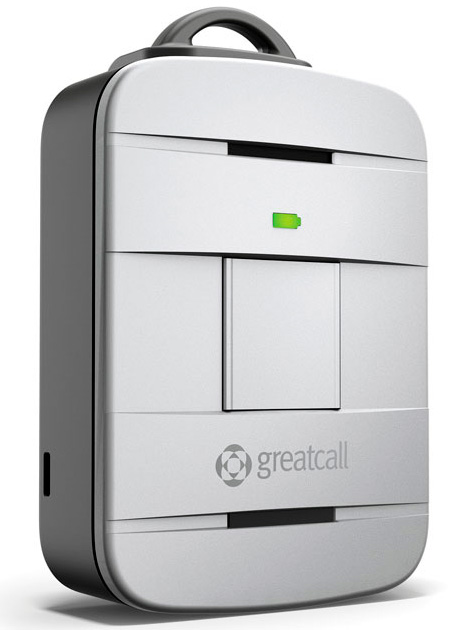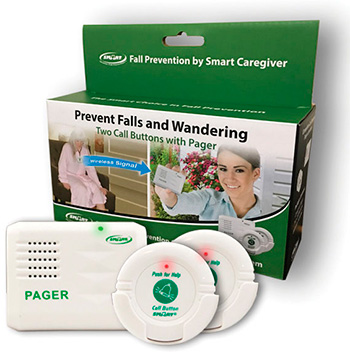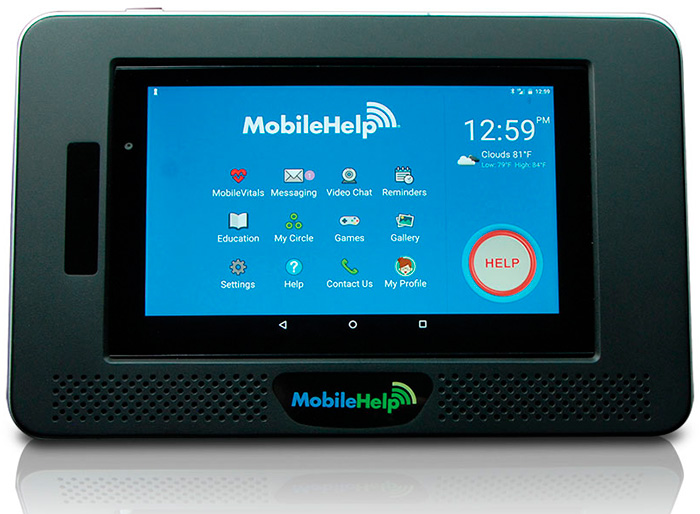 CaretakerSentry
CaretakerSentryLogicmark
Kevin O’Connor, President www.logicmark.com What products does your company offer? O’CONNOR: LogicMark manufactures systems that can be monitored by a 24-hour call center for a monthly fee as well as systems that call 911 directly or friends/family first and then 911 if the call is not answered. We also sell mobile PERS units that call the central station and allow the user to speak to the operator through the pendant. The central station can locate the user through GPS. How are you adjusting for upcoming market trends? O’CONNOR: We will see continued expansion of technology for traditional in-home PERS units as well as mobile PERS in the area of health and activity monitoring. Our strategy is to have our engineering team work on miniaturizing and embedding the technology into devices in a form that is easily wearable. How can your products help HME and other providers succeed? O’CONNOR: We believe that offering PERS can help provide additional revenue streams as well as the opportunity for some companies to differentiate themselves. We have worked with some providers that use PERS as a value add and a way to increase customer touch through custom, private-labeled pendants promoting their brand.
 Lively Mobile
Lively MobileGreatCall
Jeff Polizzotto, VP of Connected Health www.greatcall.com Tell us what your company offers in home monitoring and PERS. POLIZZOTTO: When it comes to home monitoring, we have everything from flip phones and smart phones that have emergency response services on them to help older adults stay healthy, independent and in their homes. When you move a step further into the PERS market, we introduced an mPERS device that acts as a single-button cellphone. Are you noticing any trends in the industry? POLIZZOTTO: Seniors overwhelmingly want to stay in their homes. We are seeing certain technologies helping this become a reality. When you look at some of the passive remote monitoring occurring today, and what you can do actively with a PERS device, the major trend is to...become proactive and try to avoid a situation. What are you doing to stay competitive in the next year? POLIZZOTTO: Our big push is to gather all the data we can from an mPERS device to analyze how and why falls happen in order to prevent them. This is how we are going to stay competitive in the market and bring continual added value.
 Two Call Button Paging System
Two Call Button Paging SystemSmart Caregiver Corporation
Greg Sexton, National Sales www.smartcaregiver.com What does your company bring to home monitoring/PERS? SEXTON: Smart Caregiver Corporation specializes in the development of PERS solutions designed to safeguard at-risk individuals from fall and wandering injuries. These constitute an array of passive and active monitoring devices. Have you noticed any trends in customer demand? SEXTON: One trend is cord-free and wireless technology. We provide a comprehensive array of wireless home monitoring solutions. The second trend is toward quiet monitoring solutions that minimize startling, noisy alarm units. Smart Caregiver offers solutions that allow family members and caregivers to be notified remotely and discretely when an at-risk individual needs assistance. What difficulties do HME providers face, and how do you help them overcome them? SEXTON: One of the biggest challenges is a lack of knowledgeable product support and guidance. We have launched a complete line of retail packaged kits specifically designed for the home user.
 Tablet-based system
Tablet-based systemMobileHelp
Rob Flippo, CEO Chris A. Otto, SVP, Healthcare division www.mobilehelp.com Tell us about what your company can provide in terms of home monitoring/PERS. FLIPPO: MobileHelp has sought to bring combination technologies to the industry to allow its customers to not only manage their safety, but their health as well, recognizing that the two are inextricably connected. We recently introduced MobileVitals, which allows patients to take and track their own vital signs from home. Corresponding back-end software allows clinicians to use MobileVitals as a complete RPM solution. What changes have you seen in the health care landscape? OTTO: One of the biggest changes is the move from a traditional fee-for-service (FFS) model to a fee-for-value (FFV) model, to better support care providers as they look at ways to keep patients healthy, as opposed to bringing patients back to the hospital to recover from their conditions. This change in payment approach has had the effect of incentivizing health care providers to look at new approaches to care delivery. Is there anything new your company is working on? FLIPPO: The company recently announced a new tablet-based medical alert system that will also be compatible with the MobileVitals services. In addition to giving consumers the ability to access emergency help if and when they need it, the tablet allows consumers to track and trend their vital signs and then communicate those results to their health care provider. How can your products help HME and other health care providers? OTTO: For managed care organizations and health care providers hoping to tap into the financial incentives afforded under the FFV model, leveraging a medical alert system with RPM capability offers a tool to optimally manage chronic illness—delivering proven financial outcomes while minimizing the cost of treatment.
 CAPTION
CAPTIONEvermind
Dawn White, Director of Business Development www.evermind.us What products does your company have in the home monitoring/PERS space? WHITE: Evermind gathers information about safety and well-being 24 hours a day and provides that information to families or caregivers. Many medical alert system devices must be worn on the body. Evermind sensors plug discreetly into electrical outlets and provide reassurance that a person is in their routine without requiring them to wear a device or press a dedicated button. How do your products fit into larger industry trends? WHITE: Evermind is right in line with a more proactive, rather than reactive, approach to family caregiving through the internet of things. Right now caregivers can receive a text letting them know their family member didn't make coffee, but imagine an Evermind partnership that would allow a device to ask, "Are you okay? You didn't make coffee today." What innovations does your company plan for the next year? WHITE: Evermind is going to use machine learning to better predict what changes in a person's routine are significant.
